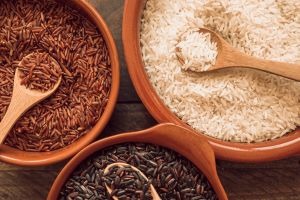by Reed Mangels, PhD, RD
In a latest submit for The Vegetarian Useful resource Group Weblog, I recognized steps shoppers can take to reduce their publicity to arsenic from rice. A reader questioned if the Thai jasmine rice, and Indian white basmati rice which had markedly much less arsenic than other forms of rice (1) have been enriched with vitamins and if that was a problem.
To start to reply this query, it’s necessary to grasp the distinction between brown and white rice. Rice is a grain, that means that it’s the seed of a cereal grass. In its much less processed kind, brown rice, the rice kernel has three components. The outer coating of the kernel is known as the bran. Contained in the bran, or outer shell, the opposite two components of rice are discovered, particularly the germ and the endosperm. The germ is the a part of the rice that may sprout into a brand new plant. The endosperm is the vitality provide for the seed. Bran is an efficient supply of fiber, nutritional vitamins and minerals. The germ can also be a superb supply of nutritional vitamins and minerals. The endosperm primarily provides carbohydrates within the type of starch.
When brown rice is processed into white rice, the outer coating (bran) and the germ are eliminated. What’s left is the starchy endosperm which has few nutritional vitamins or minerals. When white rice is enriched, a few of the nutritional vitamins and minerals that have been eliminated in processing are added again. In the US, if rice is labeled “enriched,” it will need to have thiamin, riboflavin, niacin, folic acid, and iron added (1). Different vitamins reminiscent of fiber which are misplaced in processing should not added again. Unenriched white rice doesn’t have these nutritional vitamins and iron added. I checked a number of manufacturers of Thai jasmine rice and basmati rice and none have been enriched. You may test the product label to see if the model that you’re shopping for is enriched. The desk under compares the nutrient content material of half a cup of several types of cooked rice (2).
| Sort of rice | Thiamin (mg) | Riboflavin (mg) | Niacin (mg) | Folate (mcg) | Iron (mg) |
| Brown rice | 0.09 | 0.03 | 2.06 | 4.88 | 0.39 |
| Enriched white rice | 0.13 | 0.01 | 1.16 | 45.8 | 0.94 |
| Unenriched white rice | 0.02 | 0.01 | 0.37 | 1.86 | 0.19 |
When you eat rice sometimes, the variations in vitamins between brown rice, enriched white rice, and unenriched white rice are unlikely to make a giant distinction in your total nutrient consumption. When you eat rice steadily and have determined to eat extra Thai jasmine and basmati rice to scale back your arsenic consumption, and the merchandise you select should not enriched, you’ll want to pay attention to different sources of the vitamins which are used to counterpoint rice. The Vegetarian Useful resource Group weblog and web site have details about vegan sources of riboflavin and iron. Thiamin is present in beans and complete grains together with oatmeal. Good sources of niacin embody nuts, beans, and complete grains. Folate is present in inexperienced leafy greens, fruits, beans, nuts, and complete grains.
And bear in mind, different complete grains together with barley, bulgur, and oats are good sources of fiber, nutritional vitamins, and minerals.
References
- Meals and Drug Administration, Division of Well being and Human Companies. 21 CFR 137.350. Enriched Rice. https://www.ecfr.gov/present/title-21/chapter-I/subchapter-B/part-137/subpart-B/section-137.350.
- U.S. Division of Agriculture, Agricultural Analysis Service, Beltsville Human Vitamin Analysis Heart. FoodData Central. https://fdc.nal.usda.gov/


